|
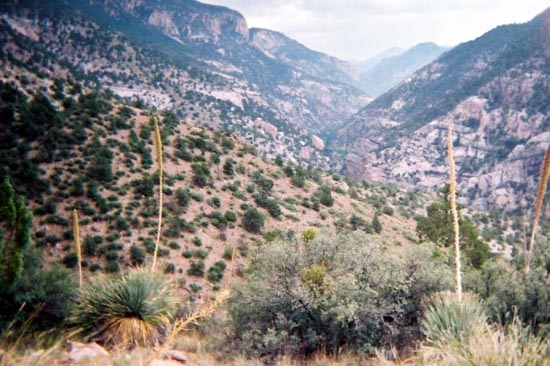
Whitewater Canyon, New Mexico, 2003, photo by
Geoff Dobson.
Between robberies, member of the Wild Bunch would retire to isolated locations far from the law such as the Big Muddy across the
border in Canada,
Robbers' Roost in Utah, Brown's Hole, Baggs on the Colorado line, or as far south
as Whitewater Canyon near Alma, New Mexico. Some contend that the gang even west as far as Ciudad Juarez.
The locations were connected by an informal route now known as the
"Outlaw Trail."
At Big Muddy there were two caves, now known as Sam Kelley's caves, named
after a home-grown Canadian outlaw. Outlaws would use the caves as hideouts until when in 1902 the
Northwest Mounted Police opened a post nearby.
South of Green River, Wyoming, lies an area extending partially into Wyoming, Colorado, and Utah into which
the law did not venture until the mid 1890's when John T. Pope was elected Sheriff of Uintah County, Utah. The
area was originally known as "Brown's Hole" but is now called "Brown's Park." As late as
1954, there was no paved road into the Utah portion of the Hole. And into this area the
Wild Bunch would periodically retreat. Others rumored to engage in rustling also resided
in the area. Rustling stopped only when several residents took bullets from a mysterious
stranger now believed to have been Tom Horn. Horn was allegedly employed by
Hi Bernard, manager of Ora Haley's Two Bar Ranch in Routt County, Colorado in the
eastern part of the Hole.
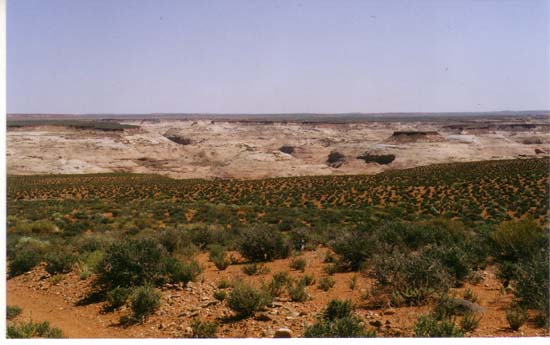
Canyons south of Hanksville as viewed from west side of Dirty Devil River.
Further to the southwest, west of the Henry Mountains in Utah, lies a desolate
area in which, even today, access is only by horse, known as Robbers Roost. The area is generally accessable only through
Dirty Devil Canyon. The Dirty Devil River received its name during the second
Powell Expedition. The name was given as a result of the color and aroma of its water. The Henry Mountains,
themselves, are so isolated that they were the last mountain range in the United States to be
named. Robbers Roost Canyon exits into the Dirty Devil near the isolated town of Hanksville, Utah. The mouth of Robbers Roost
canyon can be viewed from afar on the west side of the Dirty Devil by taking BLM sand ruts off the
hard road south of town. About 30 miles to the west of Hanksville along the Fremont is another area of narrow twisted canyons. Wthin the
canyons are small natural "tanks" of water such that they might easily be missed. Into this area in the late 19th Century, an
occasional prospector might wander in a fruitless search for yellow. These areas near Hanksville remain one of the least visited areas of the United States and
they certainly do not suffer from over-population. Hanksville has a gas station, several abandoned businesses, a church, and a Utah DOT maintenance
yard, but little more. Indeed, in this area the writer wandered one Wednesday into a convenience store to pick up
the morning Salt Lake City newspaper. He found that the only paper was Monday's. He came back
Thursday and the same papers were there. He was advised that the paper only comes on Monday.
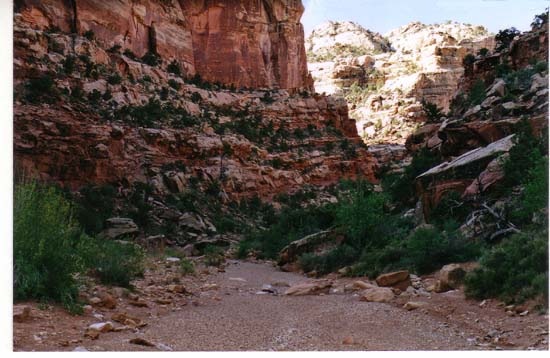
Canyon west of Hanksville.
And to these area surrounding Hanksville also the Wild Bunch would retreat. Out of the canyons, the Wild Bunch would emerge for supplies at
Charley Gibbons' store. Gibbons' daughter later recalled:
"Yes, I remember the Wild Bunch. They used to ride into
Hanksville for supplis from my father's store. Usually there were nine to twelve of them
at any one time. They were good customers and behalved like
gentlemen. They had many friends in town." As quoted by Edward M Kirby, Saga of Butch Cassidy and the
Wild Bunch (The Filter Press: Palmer Lake, CO, 1977)

In western New Mexico, hemmed in on the east by the Mogollon Mountains and on the
west by the San Francisco Mountains, is a small valley in which lies the small town of
Alma. Alma had originally been settled as an agricultural community and for a while was the
home of Billy the Kid. There, Billy's step-father operated a blacksmith shop. At its peak the town
boasted some 35 buildings including
two saloons and two stores. Pinkerton agent Charles Siringo was less complimentary, describing the town as
"a store, a saloon, and a pair of dry-rotting hitching posts." Today, the town no longer has the two stores and
saloons, but consists of little more than a road-side cafe. A short distance to
the north lies the headquarters of the W S Ranch, named after its two founders Montague Stevens and Harold Wilson, managed
by Englishman, William French.
The area early had a reputation for being a bit rough and as a refuge for outlaws. As an example, 32 miles
north of Alma was the small town of Frisco, now known as Reserve. To the town cowboys would retire for
rest and relaxation. In October 1884, some of the cowboys were having a little fun as the expense of
some of the locals of Mexican descent. With 150 cowboys having fun, the local deputy, Pedro Sarracino, rode the
129 miles to the county seat of Socorro to obtain the assistance of a "self appointed" deputy, 19-year old
Elfego Baca. One of the cowboys, Charles McCarthy, was enjoying himself by shooting into one of the
local saloons. Baca arrested McCarthy and secured him in a log house belonging to Geronimo Armijo. The house was half dugout and half
log with a sod roof. The cowboys, of course, did not like the fun being interrupted and beseiged Baca in
Armijo's cabin. Things then took an ugly turn. In attempted to disburse the mob, Baca shot into the
crowd, killing a horse. The horse's rider was pinned beneath the horse and crushed. Over the next 36 hours
Baca was under siege from about 80 cowboys. The cowboys tried to burn the cabin, but the sod roof could not
be set afire. After four cowboys were killed and eight wounded, a truce was called with the
agreement that Baca would be escorted to Socorro and stand trial.
Baca later explained the nature of the escort,"You know I surrendered only on condition that I keep my guns. They placed
six guards over me, but they rode 25 steps ahead of me all the way to Socorro." Baca was acquited, the
jury believed his actions to be self defense when the door of the cabin with some 400 bullet holes was introduced
into evidence. Of course it was all in good fun. WS Manager French excused the actions of the
cowboys on the basis that the cowboys, having come from Texas, had a remembrance of the Alamo and
"other historical events [which] were closely connected with the despised Greaser. Under the
influence of patriotism and whiskey they proceeded to give vent to their feelings." William French,
Some Recollections of a Western Ranchman: New Mexico. 1883-1899.
Later Baca sat down and had dinner with some of the cowboys who had attempted to kill him. One was Jim Cook, described by
Baca as a "pretty tough man." Some 50 years later, Cook sent Baca a photograph inscribed "To Elfego Baca in memory of that
day at Frisco." Baca's reaction, "Those were great old days. Everthing is very quiet now, isn't it?"
Baca explained the nature of the cowboys and how he became a deputy, Pete Simpson, Sheriff of
Socorro County asked him to assist in a problem with some cowboys:
"I had gone to Escondida a little way from Socorro to visit my uncle. A couple of Texas
cowboys had been shooting up the town of Socorro. They hadn't hurt anybody that time. Only
frightened some girls. That's the way they did in those days -- ride through a town shooting
at dogs and cats and if somebody happened to get in the way -- powie! -- too bad for him.
The Sheriff came to Escondida after them. By that time they were making a couple of Mexicans
dance, shooting up the ground around their feet. The Sheriff said to me 'Baca, if you want to
help, come along, but there's going to be shooting.'"
"We rode after them and I shot one of them about three hundred yards away. The other got away --- too many cottonwood trees in the way.
"Somebody asked me what that cowboy's name was. I said I didn't know. He wasn't able to tell me by the time I caught up with him."
Interview by Janet Smith with Elfego Baca, W.P.A. Writers Project, July 13, 1936.
Baca later became sheriff. When he needed to arrest someone, he would merely send him an invitation to come in. Baca explained,
" I wrote a form letter to all the men who were wanted for arrest. I told them to come into my office and give themselves up, or I would come
after them. They knew what that meant. You bet they didn't want me to come after them."
From 1892 to 1894, the sheriff of Lincoln County, the next county to the east, was
George Curry. Curry later was to serve in Roosevelt's Rough Riders and as
governor of New Mexico Territory. George Musgrave (1877-1947), later a friend of Elzy Lay, went gunning for
George Parker, a former partner in the used cow business. When the two were found with cattle for which they did not
have good title, Parker turned evidence against
Musgrave and accused Musgrave of being the one who changed the brands. In 1894, Musgrave and Bill "Blackjack" Christian, rode
into a cowcamp near Picacho, New Mexico Territoy, about 50 miles west of Roswell. Musgrave, originally from Atascosa County, Texas, was to cut a wide
swath of rustling, stage, bank and train robberies across New Mexico, Arizona, and Wyoming.
Blackjack Christian, sometimes confused with Blackjack Ketchum, made his reputation when he and his brother Bob
broke out of the Oklahoma City jail. In the ensuing gunfight at the corner of Main and
Broadway, the Chief of Police along with a compatriot of Chirstian's were killed. In 1897, Christian was killed
in a gunfight with a posse in Arizona. In the cowcamp while awaiting the arrival of Parker, Musgrave and Christian had dinner with the boys.
When Parker rode into camp for dinner, Christian held the boys at bay. Musgrave shot Parker dead and stole Parker's saddle.
Musgrave and Christian then headed west towards Alma and the Mogollon Mountains. On the way, they paused to rob the
White Oaks stage. Just how good the pickings were in the robbery of the stage is problematical. An 1886 passenger, Edith Crawford,
described the stage as "a buck board drawn by two little Spanish
mules." Sheriff Curry dispatched a posse under deputy sheriff Charles Mayer to trail the duo. Heading into the Mogollon Mountains east
of Alma, the posse stopped at the mining camp of Fairview, now a ghost town. There, Mayer was told by a local
deputy sheriff that the area ahead was the headquarters for cattle and horse thieves and was very dangerous. The posse
took the advice of the local deputy and beat it back to
Lincoln County.
Ultimately, Musgrave was caught and tried for the murder of Parker. He was
acquitted on the basis of self-defense. Parker allegedly drew first.
Nine miles to the east from Alma in one canyon was the mining town
of Mogollon, today reachable only by a one-lane road perched on the side of the canyon. The next canyon to the
south, its mouth only five miles from Alma, is Whitewater Canyon into which members
of the Wild Bunch would retreat following robberies. The isolation of the area may be indicated in that it took
the twenty-mule team ore trains from Mogollon 15 days to go the 72 miles to the mill at Silver City. The
ore trains in route passed over Hells Hill, Drunk Mans Canyon (so called because it was so
crooked, only a drunk could climb out) and Devils Canyon. Frank Leroy Ramsey later recalled that
at age 9, he accompanied his father to Mogollon. His father fell out of the
wagon and was hurt. Young Frank, by himself, had to drive a fourteen horse hitch with four wagons back to
Silver City from Mogollon. Young Ramsey was so small that to put the collars on the horses he had to
stand on an Arbuckle coffee box.
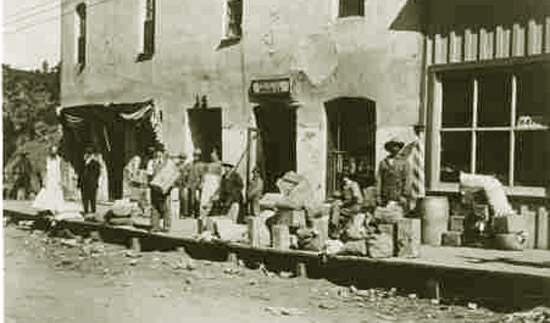
Men in front of Post Office, Mogollon, New Mexico, undate.
Even after the end
of the Wild Bunch, Mogollon remained a fairly lawless place. In 1910, Sheriff Sanchez found it necessary to
fire his deputies in the area and call in the New Mexico Mounted Police. In Mogollon, there was a shootout between one of the former
deputies, saloon keeper Charles Clark, and the mounties. Clark was a poor shot. The mounties weren't.
Whitewater Canyon is even more isolated. Today, access into the canyon on the north side of Whitewater
Creek is by means of a footpath zigzagging its way up, over, and down a 700 ft. high hill guarding the entrance to the
canyon. On the south side it is by means of a structure known as "the Catwalk" hanging from the wall of the canyon.
Arbuckle Bros. Coffee
"The coffee that won the West"
Prior to the Civil War coffee had to be made from green beans which were roasted and ground
at home. Roasted beans tended to rapidly lose their aroma and the oils would turn rancid from
exposure to air. In 1868, John Arbuckle invented a process of coating roasted beans with a combination of
egg white and sugar which filled the pores of the beans and hermetically sealed the beans so
that they would keep for months. The egg white would also settle the grounds and the sugar would sweeten the coffee. Thus,
beans could be sold already roasted in one pound bags. Arbuckle "Ariosa" coffee was popular with cowboys and freighters who
would not have the ability to roast beans on the trail. In each bag of beans, Arbuckle included a
card which would feature a map and scenes of a state, one of the 50 principal countries of the world, a sporting activity, or
a wild animal. In later years,
the back of the card would also give a thumbnail sketch of the country's or state's principal industries and history. The
paper bags of beans were shipped in wooden crates. The writer has often speculated, without any factual basis, that
Butch and Sundance first learned of Argentina from an Arbuckle's card.
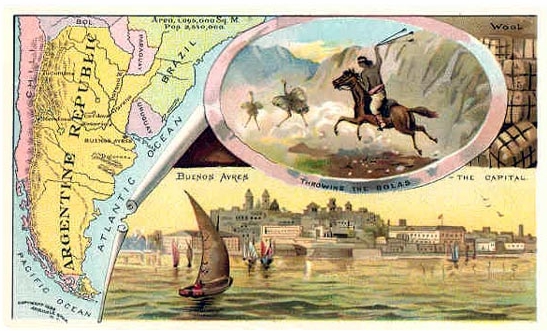
Arbuckle Bros. Coffee trade card
|
Next page: The Wild Bunch at the WS.
|